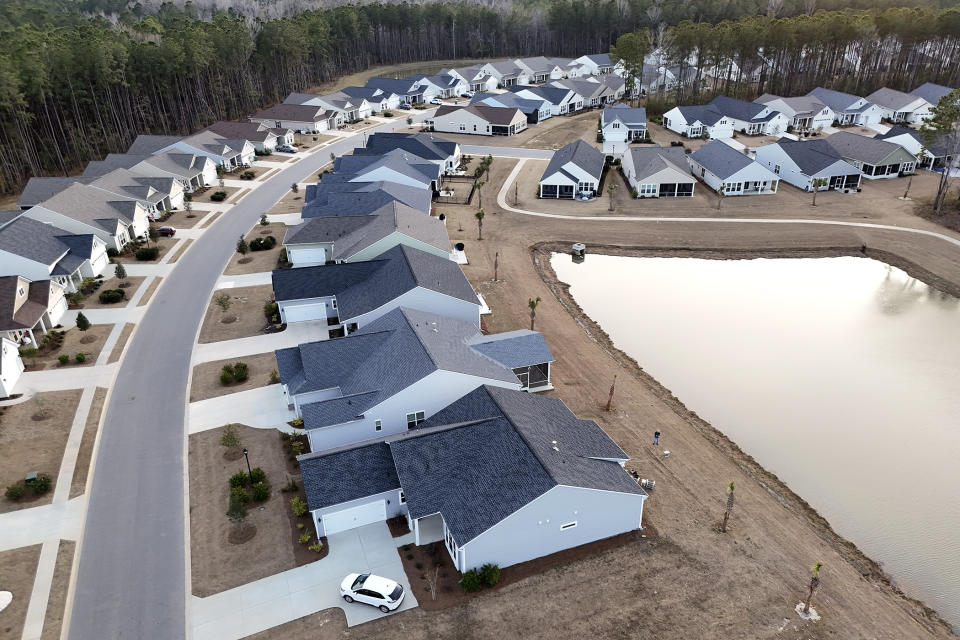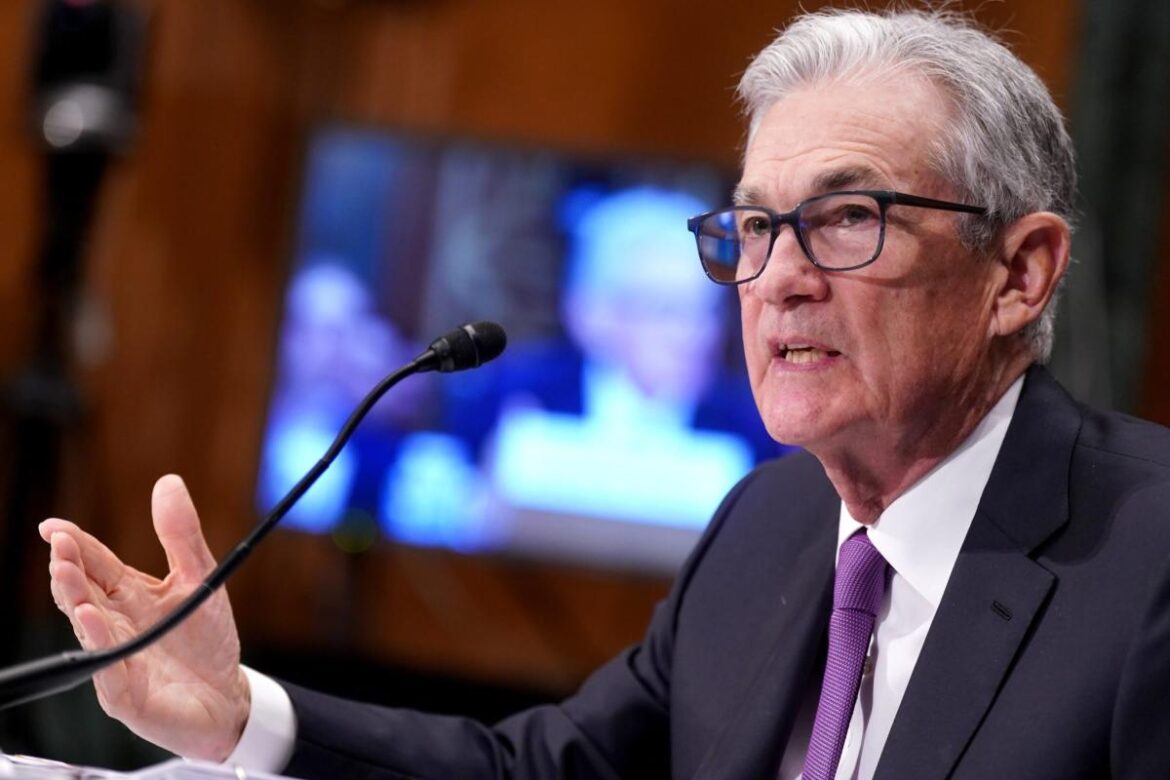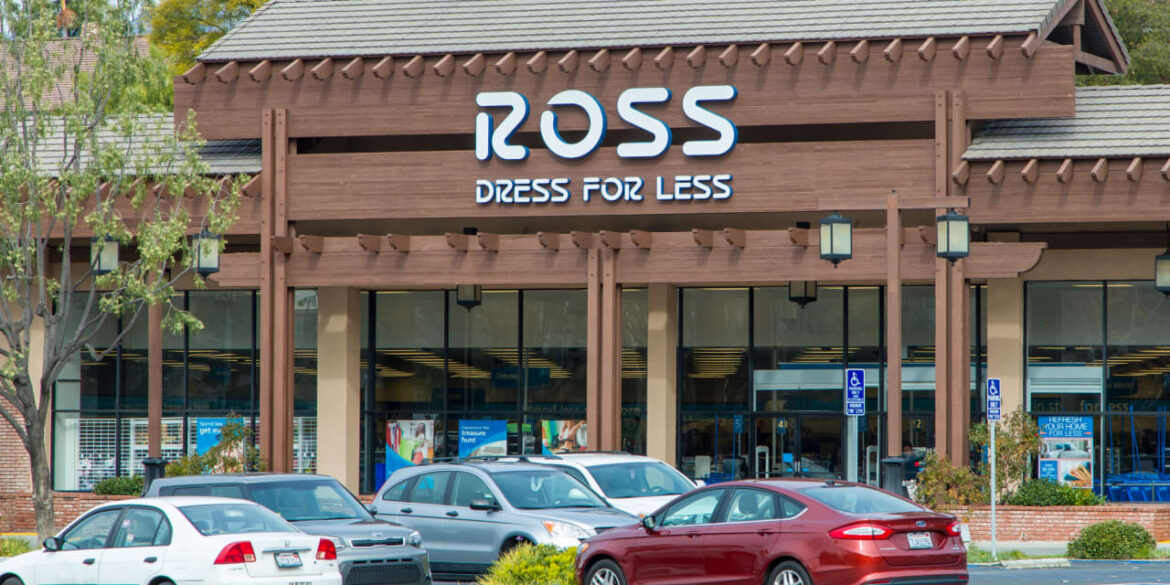
The furniture maker said that a “lagging” housing market, rising interest rates, and other headwinds contributed to lower sales.
Source link
housing
Fed’s inflation fight will affect housing supply for decades, says Redfin CEO
The housing market is showing signs of a recovery as the spring home-buying season gets underway.
Mortgage rates fell for the second week in a row, declining to the lowest level in more than a month. The average rate on the benchmark 30-year fixed mortgage fell to 6.74% from 6.88% the week prior, per Freddie Mac.
And as mortgage rates decline, supply is starting to rebound. New listings hit a 17-month high in February, while the total number of homes for sale rose to the highest level in a year, according to Redfin (RDFN).
Read more: Mortgage rates hover around 7% — is this a good time to buy a house?
It’s an improvement from last year’s depressed levels, but supply-demand remains far from balanced. The culprit: Side effects of the Fed’s aggressive rate-hiking campaign.
Top economist Gary Shilling told Yahoo Finance that the Fed’s change in interest rate policy created a “perfect storm” for the industry, with higher rates prompting would-be sellers to stay put, as many have locked in ultra-low rates during the pandemic or in the years prior.
The giant gap between current and past mortgage rates is creating “artificial tightness” in the housing market. “It won’t continue indefinitely, but it certainly is disruptive right now,” Shilling said.
Redfin CEO Glenn Kelman expects the Fed’s recent moves to affect the housing sector for decades, warning it will take years to work through the aftershocks of the central bank’s aggressive rate-hiking campaign.
“There’s going to be low supply for a long time to come,” Kelman told Yahoo Finance. “What the Fed did … will have a 30-year tail on it.”

Lackluster supply has kept home prices elevated. The median price of previously owned homes rose 5.1% in January from a year ago, with all four US regions showing price growth, according to the National Association of Realtors.
Any hope of relief for the housing sector may be postponed. A series of hotter-than-expected inflation prints has bolstered the case for policymakers to delay rate cuts, according to Oppenheimer’s John Stoltzfus. He told Yahoo Finance Live that he thinks the Fed won’t cut rates until at least its June meeting.
A delayed rate cut suggests, at least in the near term, that mortgage rates are unlikely to fall much further, potentially postponing a more substantial rebound in the housing market.
“We need more supply. The real gate on home sales has been the number of homes for sale,” Kelman explained. “If interest rates don’t come down significantly, we’ll see a modest uptick in inventory, but to see a big gain, you’re going to have to see a real drop in mortgage interest rates.”
Moody’s Analytics expects a total housing deficit of 1.5 million to 2 million units this year, with a shortfall of up to 1.2 million for single-family homes.
Seana Smith is an anchor at Yahoo Finance. Follow Smith on Twitter @SeanaNSmith. Tips on deals, mergers, activist situations, or anything else? Email seanasmith@yahooinc.com.
Click here for real estate and housing market news, reports, and analysis to inform your investing decisions.
Jerome Powell says ‘the housing market is in a very challenging situation right now’ and interest rate cuts alone won’t solve a long-running inventory crisis
The housing market has a problem—millions of them. The country is short between 3.5 and 5.5 million housing units, according to various estimates. The roots of the shortage go back to the aftermath of the Global Financial Crisis, when cautious developers were hesitant to invest in new construction and set a precedent of undersupply that’s continued to now. Jerome Powell.
On Thursday, the Federal Reserve chair testified to the Senate Banking Committee against the backdrop of his recent decision not to cut interest rates, the big question investors and homebuyers are asking. Potential rate cuts have given investors hope about some much-needed relief for the housing market, which has struggled to cope with soaring mortgage and refinancing rates, but Powell testified that the housing market’s real problems run much deeper—and it will take more than just monetary policy to fix them.
“The housing market is in a very challenging situation right now,” Powell said on Capitol Hill on Thursday. “Problems associated with low rate mortgage [lock-in] and high [mortgage] rates and all that, those will abate as the economy normalizes and as rates normalize,” he said, referring to the mismatch between something approaching 90% of homeowners with mortgage rates below 6% and the current market offering above 7%. “But we’ll still be left with a housing market nationally, where there is a housing shortage.”
‘There are a ton of things happening’
Powell explained the current problems facing homebuyers and sellers to the committee: “You have a shortage of homes available for sale because many people are living in homes with a very low mortgage rate and can’t afford to refinance, so they’re not moving, which means the supply of regular existing homes that are for sale is historically low and a very low transaction rate,” Powell said. “That actually pushes up the prices of other existing homes, and also of new homes, because there’s just not enough supply.”
But it’s a bigger issue than buyers and sellers being locked in, he said. “There are a ton of things happening … because of higher rates, and those in the short-term are weighing on the housing market … it’s more difficult [for builders] to get people [labor] and materials,” Powell said. “But as [mortgage] rates come down, and that all goes through the economy, we’re still going to be back to a place where we don’t have enough housing.”
The pandemic only made things worse. High inflation has made materials and labor costs far pricier, and ballooning mortgage rates have pumped the brakes on an already-slow sector. National Association of Realtors data showed that there were only 3.2 months of available housing supply as of the end of last year, about half as much as there should be in a balanced market.
Markets expect the Fed to announce rate cuts this year—but while that will offer some short-term relief, it won’t solve the housing market’s deep–set supply problems.
Powell noted that restrictive zoning laws play an important role in limiting new construction. He also pointed out that rising mortgage rates have discouraged longtime homeowners who locked in lower rates from moving, which has limited the number of existing homes on the market and left new homebuyers struggling to find affordable options.
Powell’s threading a tricky needle—the housing market is a big driver of the domestic economy, and overstressing it by keeping interest rates high for too long could threaten the rest of the economy. On the other hand, cutting rates too soon—or too quickly—in line with the industry’s demands could undermine the Fed’s yearslong attempts to stick a soft landing and keep inflation under control.
“Housing activity accounts for nearly 16% of GDP according to NAHB estimates,” wrote a group of housing industry trade organizations in a letter to Powell last fall. “We urge the Fed to take these simple steps to ensure that this sector does not precipitate the hard landing the Fed has tried so hard to avoid.”
This story was originally featured on Fortune.com
Ross Stores says that housing and food costs continue to pressure its customers

Ross Stores Inc. late Tuesday blew past expectations for its holiday quarter but spooked investors by saying that higher costs of living continue to pressure its customers.
While inflation has moderated, there is ongoing macroeconomic and geopolitical uncertainty, and “housing, food, and gasoline costs remain elevated and continue to pressure our low- to moderate-income customers’ discretionary spend,” the off-price retailer said.
“As a result, while we hope to do better, we believe it is prudent to continue to take a conservative approach to forecasting our business in 2024,” the company said.
Ross
ROST,
earned $610 million, or $1.82 a share, in the fourth quarter, compared with $447 million, or $1.31 a share, in the year-ago period.
Sales rose to $6 billion from $5.2 billion a year ago, and comparable-store sales were up 7% over the same period last year.
Analysts polled by FactSet expected the retailer to report earnings of $1.66 a share on sales of $5.8 billion. Same-store sales were forecast to be up 3.4%.
“Our above-plan sales were driven by customers’ positive response to our improved assortments of quality branded bargains throughout our stores,” Ross Chief Executive Barbara Rentler said in a statement.
Ross said it expects 2024 same-store sales to grow 2% to 3%, which would come on top of a 5% gain in 2023. It projected 2024 EPS between $5.64 and $5.89. First-quarter EPS was projected to be between $1.29 and $1.35.
The FactSet consensus calls for 2024 EPS of $5.40 a share and first-quarter EPS of $1.26.
Target Corp.
TGT,
earlier Tuesday beat Wall Street expectations for its fourth quarter but said that despite encouraging signs for the U.S. economy, some of its customers feel “stretched.”
Ross’s fourth-quarter operating margin rose to 12.4% from 10.7% year over year, thanks to “strong gains” in same-store sales and lower freight costs, which were partially offset by higher discounts, the company said.
Shares of Ross rose 1.8% in after-hours trading.
Ross said that its board authorized a 10% increase in the company’s dividend, to 36.75 cents a share. The dividend is payable on March 29 to stockholders of record as of March 15, the company said.
“As we move through the coming year, we remain focused on delivering a wide assortment of quality branded bargains for our customers. We believe this will be the most important driver of our ability to gain market share over both the short and long term,” Rentler said.
Low-income seniors get $115 million in housing help, but the need is far greater

Low-income older adults, including those raising grandchildren, just got a boost for housing assistance, but analysts say funding more is needed.
The U.S. Department of Housing and Urban Development (HUD) recently announced $115 million in grant funding to support the development and improvement of affordable rental housing for low-income seniors. Of that funding, $35 million is earmarked to create intergenerational housing for households headed by seniors who are raising children under 18 years of age.
“Creating these homes will enable older adults to live independently. It is important that we provide opportunities for seniors of modest means to age with grace and dignity in a supportive environment,” said HUD Deputy Secretary Adrianne Todman.
The funds will help non-profit organizations create new homes that are energy efficient, or rehabilitate existing ones, for low-income adults 62 years of age or older. Funding is provided to support capital costs and ongoing project rental assistance.
This new batch of funding builds on another similar funding tranche of $161.1 million in Section 202 housing grants that were awarded to 25 grantees in 14 states. That funding will be used to create nearly 1,300 units for eligible households.
“Having access to housing that is affordable for all of our seniors is critical. This is going to be even more important moving forward given the significant growth in our older adult population,” said Lisa McCracken head of research and analytics, the National Investment Center for Seniors Housing & Care.
Read: Dream of aging in place? This government program could be a game-changer for seniors
“The $115 million in funding that HUD has announced certainly acknowledges the need for additional housing to support low-income older adults and is welcome news. Most would agree that there is a need for even greater funds, not only for low-income seniors, but also for those who are just above the income threshold for government support, otherwise known as the middle market. Having said that, this funding is a step in the right direction,” McCracken said.
Read: Where can I afford to live in retirement? Senior housing and the ‘forgotten middle’
The funding also comes as people want to age in place, but finding age-friendly housing is difficult. As many as 77% of people aged 50 and older want to stay in their own home as they age, but only 49% think that they will be able to do so, according to AARP.
Finding a home that is accessible to older people or those with disabilities is challenging. For example, less than 4% of all U.S. homes offer single-floor living, no-step entries, and wide hallways and doorways, according to Harvard University’s Joint Center for Housing Studies’ analysis of 2011 survey data.
Read: Most people want to age in place — but that goal is out of reach for almost everyone
“These funds, allocated for both rental assistance and development costs, offer a solution to address the persistent housing needs of seniors across the nation,” said Assistant Secretary for Housing and Federal Housing Commissioner Julia Gordon. “We are maintaining our commitment to supporting safer, healthier, more energy-efficient homes that help address both the climate crisis and the housing crisis together.”
The grants offer adults aged 62 and older the chance to live independently with tailored support services, including nutrition, transportation, education, and health services, HUD said.
Eligible seniors typically have less than 50% of the area median income, with most households earning below 30% of the median for their locality.
“There are far too few affordable housing options for older adults across the country, particularly for those who need support to live on their own as they age. Expanding Section 202 housing is key to providing more affordable, accessible housing options,” said Rodney Harrell, vice president of family, home and community at the AARP Public Policy Institute.
In 2021, 2.35 million older adult renters had “worst case housing needs.” That category means that these renters have very low incomes (incomes at or below 50% of area median income) and do not receive government housing assistance, and they are severely cost burdened, live in severely inadequate housing conditions, or both, according to a 2023 HUD Worst Case Housing Needs Report.
Read: ‘We don’t have enough homes to meet our aging needs’: The ideal home for aging in place might not even exist
In 2021, nearly 11.2 million older adult households were cost burdened, and over half of those households were severely cost burdened, according to the 2023 Harvard JCHS Housing America’s Older Adults Report.
Meanwhile, the funds designated for intergenerational housing will help the unique needs of grandparents caring for grandchildren.
“Roughly 2.3 million grandparents in the U.S. are responsible for raising their grandchildren, which can often result in increased financial burden. This targeted funding will help address the needs of that segment in particular,” McCracken said.
About 16.2% of grandchildren under the age of 18 living with grandparents were living in poverty, according to the Census Bureau.
The Port of Fontvieille Harbor in the Principality of Monaco.
Education Images | Universal Images Group | Getty Images
The ultrawealthy are looking for a better lifestyle and strong investment when it comes to buying their next home, according to a new study.
One-quarter of American ultra-high-net individuals, or those worth $30 million or more, plan to buy a residential property this year, according to the Douglas Elliman and Knight Frank Wealth Report. The average ultra-high-net-worth individual already owns four homes, according to the report. One-quarter of their residential portfolio is outside their home country.
When it comes to priorities for their next big purchase, the ultrawealthy ranked “lifestyle” and “investment” at the top of the list, followed by taxes and safety.
Sign up to receive future editions of CNBC’s Inside Wealth newsletter with Robert Frank.
While luxury real estate has been buffeted by many of the same pressures as the rest of the market — low supply, slow sales, rising prices — the ultra-high-end has fared slightly better. Last year in the U.S., there were 34 sales over $50 million, down from 45 in 2022 but still way up from the pre-pandemic years.
With interest rates stabilizing and possibly falling this year, real estate experts say there are early signs that luxury supply may be growing, which could lead to more sales.
“If we do see a pivot to lower rates, or at least more confidence that inflation is going in the right direction, I think you will begin to see inventory building up again,” said Liam Bailey, partner and global head of research at Knight Frank.
The report forecasts that the best-performing U.S. luxury market this year for price growth will be Miami, with an expected increase of 4%, according to the report. New York ranked second in the U.S., with expected price growth of 2%, followed by Los Angeles with 1% growth.
Globally, the top market for luxury real estate is expected to be Auckland, New Zealand, with projected price growth of 10% in 2024. Mumbai ranks second, at 5.5%; followed by Dubai (5%); Madrid (5%); Sydney (5%); and Stockholm (4.5%).
Cars drive along a street in front of high-rise buildings in Dubai, on February 18, 2023. Dubai saw record real estate transactions in 2022, largely due to an influx of wealthy investors, especially from Russia.
Karim Sahib | Afp | Getty Images
Last year, the world’s top 100 luxury real estate markets posted a solid 3% gain on average price. The best-performing luxury real estate market in the world was Manila, Philippines, with 26% growth, fueled in part by investors fleeing Hong Kong and China. Dubai came in second place, at 16% price growth, followed by the Bahamas at 15% and the Algarve region in Portugal at 12%.
Among the worst performers last year were New York, with prices down 2%, and San Francisco, basically flat at 0.5%. The biggest decline in the world among prime markets was Oxford, in the U.K., down 8%.
Bailey said ultrawealthy American buyers are increasingly venturing overseas. He said U.S. buyers are now the leading foreign purchasers of ultraprime London properties — those priced above $10 million. They are also increasingly active in Europe.
“They’ve become quite a big presence, so much more noticeable now in Italy, France and Portugal particularly than they were,” Bailey said. “I think the American buyers have become much happier to explore and kind of think about alternatives.”
Still, $1 million doesn’t buy what it used to in the U.S. and abroad. In Monaco, the world’s most expensive real estate market, $1 million gets you 172 square feet of prime real estate, according to the Wealth Report. In Aspen, you get 215 square feet, while in Hong Kong, you get 237 square feet, which makes New York look like a bargain with 367 square feet.
Don’t miss these stories from CNBC PRO:
With a New CEO and Improving Housing Market, Could 2024 Be a Big Year for Opendoor?
After a difficult 2022 as the housing market cooled off, Opendoor (OPEN -0.89%) was one of the stock market’s top performers of 2023. The iBuyer just made a major leadership change, and the real estate market looks as if it could finally be turning a corner. What’s in store for 2024?
*Stock prices used were the afternoon prices of Jan. 25, 2024. The video was published on Jan. 26, 2024.
Matthew Frankel, CFP® has no position in any of the stocks mentioned. Tyler Crowe has no position in any of the stocks mentioned. The Motley Fool has positions in and recommends Opendoor Technologies. The Motley Fool has a disclosure policy. Matthew Frankel is an affiliate of The Motley Fool and may be compensated for promoting its services. If you choose to subscribe through their link they will earn some extra money that supports their channel. Their opinions remain their own and are unaffected by The Motley Fool.
The U.S. Has a Housing Crisis — Here Are 2 Stocks That Could Be Big Winners From It
While experts disagree on the exact number of housing units we need, there’s undoubtedly a serious housing shortage in the United States. In this video, Fool.com contributors Matt Frankel, CFP®, and Tyler Crowe each discuss one stock that could be a long-term beneficiary.
*Stock prices used were the afternoon prices of Jan. 12, 2024. The video was published on Jan. 14, 2024.
Matthew Frankel, CFP® has positions in Walker & Dunlop. Tyler Crowe has positions in Green Brick Partners. The Motley Fool has positions in and recommends Green Brick Partners and Walker & Dunlop. The Motley Fool has a disclosure policy.
Matthew Frankel is an affiliate of The Motley Fool and may be compensated for promoting its services. If you choose to subscribe through their link, they will earn some extra money that supports their channel. Their opinions remain their own and are unaffected by The Motley Fool.











